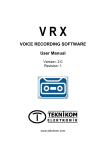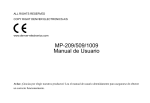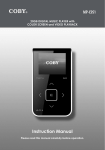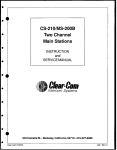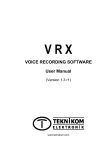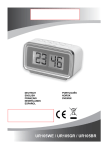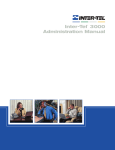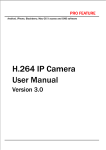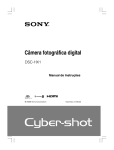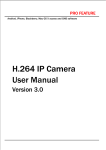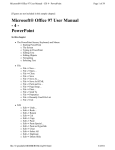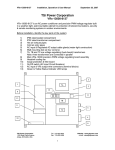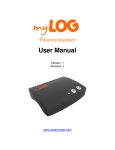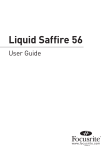Download User Manual
Transcript
VRX VOICE RECORDING SOFTWARE User Manual Version: 3.0 Revision: 2 www.teknikom.com ABOUT VRX VOICE RECORDING SOFTWARE ..................................................................1 VRX IN BRIEF ................................................................................................................... 1 IMPORTANT ..........................................................................................................................2 LEGAL WARNING ............................................................................................................ 2 SECURITY WARNING ...................................................................................................... 2 NECESSARY COMPUTER CONFIGURATION .....................................................................3 USING VRX ...........................................................................................................................4 OPENING THE USER INTERFACE .................................................................................. 4 CHANGING THE USER PASSWORDS ........................................................................ 6 SHUTTING DOWN THE COMPUTER ............................................................................... 6 VIEWING MULTIPLE SITES IN SINGLE WINDOW .......................................................... 6 SAVING SERVER ADDRESSES ...................................................................................... 7 MONITORING CHANNELS............................................................................................... 8 REAL TIME LISTENING ................................................................................................ 8 COLUMNS IN THE TRACE WINDOW........................................................................... 8 CHANGING TRACE VIEW ............................................................................................ 9 SMDR – STATION MESSAGE DETAIL RECORDING .................................................. 9 SEARCHING AND LISTENING TO THE PAST RECORDINGS ......................................10 CALL STATISTICS AND ANALYSIS...............................................................................12 OPERATIONS ON RECORDINGS...................................................................................12 GRAPHICS ......................................................................................................................14 PHONE BOOK .................................................................................................................16 LISTING THE PHONEBOOK ENTRIES .......................................................................16 ADDING A NEW ENTRY ..............................................................................................16 MODIFYING THE PHONEBOOK ENTRY ....................................................................17 DATA EXCHANGE WITH OTHER APPLICATIONS .....................................................17 ALARM REPORTING ......................................................................................................18 SYSTEM SETTINGS ............................................................................................................19 GENERAL SETTINGS .....................................................................................................19 STORAGE ....................................................................................................................19 E-MAIL SETTINGS .......................................................................................................21 DEVICE LICENSES......................................................................................................21 BACKUP ALARM .........................................................................................................22 SERVICE CONTROL ...................................................................................................22 SMDR SETTINGS ........................................................................................................22 OPERATING MODE .....................................................................................................22 TIME DEPENDENT RECORDING ...............................................................................22 CHANNEL SETTINGS .....................................................................................................23 COLUMNS IN CHANNEL SELECTION WINDOW ........................................................23 EDITING SELECTED CHANNEL(S) .............................................................................24 NUMBER DEPENDENT RECORDING.........................................................................25 RADIO RECORDING SETTINGS .................................................................................26 EXTENSION SETTINGS ..............................................................................................26 USER PROFILES.............................................................................................................27 USERS .............................................................................................................................28 E-MAIL RULES: ...............................................................................................................30 SENDING E-MAILS AFTER RECORDING ...................................................................31 SENDING E-MAILS AS SCHEDULED..........................................................................31 BACKUP ..........................................................................................................................31 CREATING NEW BACKUP TASK ................................................................................32 MODIFYING EXISTING BACKUP TASK ......................................................................32 TEMPORARILY DISABLING BACKUP TASK ..............................................................32 BACKUP TASK PARAMETERS ...................................................................................32 BROWSING BACKUPS ................................................................................................32 VOIP RECORDING SETTINGS .......................................................................................33 DEMO PERIOD ............................................................................................................34 LICENSING VIA INTERNET ........................................................................................34 LICENSING WITH DONGLE ........................................................................................36 CONNECTIONS FOR VOIP RECORDING ...................................................................38 ALARMS AND SYSTEM INFO ........................................................................................43 REMOTE CHECK OF VRX ..............................................................................................43 USING THE ANNOUNCE CARD .........................................................................................43 WELCOME ANNOUNCE: ................................................................................................43 ANSWERING MACHINE: ................................................................................................44 RECORDING THE MESSAGE: ........................................................................................44 HINTS ..................................................................................................................................45 INCREASING VOICE QUALITY ......................................................................................45 MULTIPLE SELECTION ..................................................................................................45 LOG FILE .........................................................................................................................45 TROUBLESHOOTING .........................................................................................................45 FORGOTTEN PASSWORD .............................................................................................45 CAN NOT COMMUNICATE WITH RECORDER DEVICE ................................................45 CAN NOT RECORD .........................................................................................................46 NOISE ON RECORDINGS ...............................................................................................46 CAN NOT SEE CALLING NUMBER ................................................................................46 CAN NOT ACCESS VRX OVER NETWORK ...................................................................46 CONNECTION IS LOST AFTER WHILE..........................................................................46 CAN NOT SEE CHANNELS ............................................................................................46 CAN NOT RECORD IN MP3 FORMAT ............................................................................47 INTERRUPTIONS ON RECORDINGS .............................................................................47 CAN NOT BACKUP ON OTHER COMPUTERS ..............................................................47 RECORDING PROPERTIES................................................................................................48 ABOUT VRX VOICE RECORDING SOFTWARE This document has been prepared according version 3.0 of VRX voice recording software. In this manual, usage of the software explained in details with examples. Hardware and software installation guides are supplied together with equipment. Hardware and software upgrades can be checked from the web site: www.teknikom.com VRX allows VoIP, analogue and ISDN telephone communications to be recorded on a PC. Up to eight recording devices can be connected to a single computer. When connected to the network, same features can be used from any computer in the network. If the computer has internet access, VRX can be reached from all over the world. In order to use VRX via network and/or internet, all devices handled by VRX, must have network license. WARNING: Please read this manual carefully before installing and using voice recorder. If any trouble encountered during installation/operation, refer this manual first, then call service. NOTE: This manual has been prepared according VRX software version 3.0. Check TEKNİKOM web site to see if newer versions of software and user manual available. VRX IN BRIEF Up to 128 lines can be recorded simultaneously by connecting up to eight devices to a single computer. VRX is a multi-type voice recording platform capable of recording analogue PSTN lines, e1 ISDN lines, VoIP, wireless communications, room voices etc. Past recordings can be searched according selected lines, date & time, duration, calling/called number, direction of call, phone book name or added notes. Powerful SMDR feature adds extension number information to recordings when connected to CO line terminals of a PABX. VRX can be programmed as to record (or not to record) in certain times of certain days. Recordings can be analyzed with variety of graphic analysis tools and can be shared with colleagues. Program runs as Windows Service. User interface can be opened whenever needed. Unauthorized access to recordings and settings prevented by multilevel, multiuser password structure. VRX can be used to break conversations on analogue lines according user basis programmable duration limits and credit schedule with optional line breaker card. Channel basis “Record if dialed” feature allows recording of calls to/from certain numbers. VRX User Manual (v3.0 – r2) Page: 1 / 48 Channel basis “Do not Record if dialed” feature prevents recording of calls to/from certain numbers. All features can be accessed via intranet/internet with optional network license (some devices and VoIP recordings includes network license by default); - Administration of recording system, - Listen ongoing conversations, - Search past recordings etc. One of several compression algorithms can be selected (including MP3). With auto E-mail sending feature; - Alarms automatically sent to programmed recipients. - Several e-mail rules can be defined. VRX automatically sends email to the recipients whenever a rule matched. For example, call to/from a certain number, calls of last week, calls between certain hours. - Same or different recipients can be defined for each rule. With automatic backup facility, a copy of recordings can be saved to another folder, computer and/or CD/DVD at scheduled time intervals. Manual recording feature lets user to start recording any time. Recordings can be exported or e-mailed. Individual recording files can be listened with independent VRXplayer program. In which, all information about the recording (voice graphic, server name, record date/time, type of call, calling/called numbers etc.) can be seen. Shut-down password prevents unauthorized person to shut-down the VRX. Recordings can be encrypted. IMPORTANT LEGAL WARNING Monitoring and recording of telephone conversations is under user’s responsibility. Read license agreement during installation and return purchased equipment if you are not agree with terms. System has BEEP insertion feature to the analogue telephone lines to inform parties about the conversation is being recorded. Another way to inform parties about the conversation is being recorded, is playing announcement when call answered. BEEP modules and announcer devices are sold separately. SECURITY WARNING Recordings are stored in computer’s HDD as WAV files. Consult computer specialist to prevent local/network users’ access to recordings via operating system. VRX User Manual (v3.0 – r2) Page: 2 / 48 NECESSARY COMPUTER CONFIGURATION CPU: Up to 8 channel systems, Pentium-D 1.5GHz or better. For higher capacities, PentiumD 2.8GHz or better. MEMORY: Up to 16 channel systems, 1GB. Up to 32 channel capacities, 2GB, for higher capacities 4GB. USB PORT: 1.1 or 2.0 OPERATING SYSTEM: ME, XP, XP Pro, Windows2000, Server2003, Vista or Windows-7. DISC CAPACITY: 20MB free space required for program itself. Necessary space for recordings depends the size of application. 35 to 280 hours of recordings stored in 1GB disc space depending on selected compression algorithm. BACKUP: Any storage media can be used. A network device can be used as backup device if connected to a network. Network license is not necessary for this. VRX User Manual (v3.0 – r2) Page: 3 / 48 USING VRX VRX is a client/server type application. Server runs at the background and starts automatically when computer starts up even before user session opened. VRX continues recording even if client window is not opened. Client provides user interface and can be opened whenever necessary. Recordings can be searched and listened and system administrated via client. In order to access recordings via another computer over the network, this program (VRX.EXE) should be copied to the other computer as well. OPENING INTERFACE THE USER On the VRX program window, there are buttons for selecting which action to take. These buttons are grouped as “Use” and “Settings”. User Controls: This group of functions are for all users (admin and non-admin). Each user can use the program within authorization limits. Administrative controls: These are to make administrative settings of the system. This group of settings are only visible to the system administrator. Figure-1 VRX User Manual (v3.0 – r2) Page: 4 / 48 When the VRX client first starts, the trace window (Figure-2) appears directly. Figure-2 If program is being used with password protection, the user entry window (figure-3) is opened. After entering the user name and password, the trace window is opened. Figure-3 VRX User Manual (v3.0 – r2) Page: 5 / 48 CHANGING THE USER PASSWORDS The users may change their passwords by the password menu (figure-4) opened clicking the in the user interface. Figure-4 SHUTTING DOWN THE COMPUTER If Shutdown password defined to increase system security, VRX has to be closed prior to shutting down the computer. When button is pressed, user is asked to enter shutdown password. This button is active only for local users (not accessing via network) and if shutdown password is not blank. VIEWING MULTIPLE SITES IN SINGLE WINDOW With VRX software on your computer, it is possible to connect or access to the recordings of the other VRXs in the same network. To achieve this, the VRX services in the computers should be running and the network license keys should be entered. To access the VRX programs in other computers, click the “connect” button to enter the address. After typing the IP address or name of the target computer, click the So the target’s user interface window appears (figure-6). Figure-5 VRX User Manual (v3.0 – r2) Page: 6 / 48 button. If the admin password is not blank in the target computer, user name and password should be entered in the “Login” window. As many servers as can be connected in the same window. Each server is shown in it’s tab. To switch between servers, just click on the related server label as in Figure-6. Figure-6 Users may disconnect from the selected server any time, by clicking the button. NOTE: To access to the recordings on a computer via internet, be sure that; - Recording and access computers are connected to the internet, - The recording devices connected to the computers have network support. - The modem IP is known, - TCP port 17000 is directed to the recording computer. For further information, contact equipment supplier. SAVING SERVER ADDRESSES VRX client has address book in order to keep information about various VRX servers. With auto log-in feature, user can automatically log-in to several sites when running client program. To open the address book, click on the top of VRX client program. IP addresses of remote sites should be filled in. Network name can be used instead of IP address for computers in the same local network. The user name and password should also be entered for each site. If “Auto Connect on Startup“ is checked, servers are automatically connected as VRX client opening. After adding each server, button should be pressed. VRX User Manual (v3.0 – r2) Page: 7 / 48 MONITORING CHANNELS To monitor or listen to the channels in real-time, “Trace” button should be pressed in user controls group (figure-2). Each channel is shown as a single line in the opened page. The channels being recorded are highlighted with bold lines and duration counter increments. REAL TIME LISTENING To listen to an ongoing conversation, click on the speaker symbol in the channel’s line. Press the same button to end listening. While listening, you may switch directly to another channel by pressing the other channel’s button. If speaker button remains pressed at the end of conversation, listening continues with the new conversation starts on the same channel. NOTE: Real time listening does not work for both VoIP recording and for the MP3 compression method. COLUMNS IN THE TRACE WINDOW Channel: Given name to individual channels. This is always in “IP Channel n” format and can not be changed for VoIP recording. Extension: Name of the extension line user, talking on specific CO line of PABX. This column is visible if SMDR feature is active. Starting time: The time when the conversation starts. Duration: Elapsed time after the recording starts. Type: In this column, type of call is indicated with symbols. Outgoing phone call Incoming phone call Missed (unanswered) phone call Wireless communication recording Room recording VoIP recording Number: The phone number of calling or called party. Name: If the phone number exists in the phone book, corresponding name shown in this column. You may open the “phone book” page by double clicking to the name. Important: During the conversation, you may click this column to mark the conversation as important. This flag then can be used as a parameter when searching past recordings. Add note: Click to add notes to ongoing conversations. Speaker: Click this button to listen ongoing conversations. Auto Answer mode: This mode can only be activated if voice recorder is equipped with announce card. When active, incoming calls on that line are answered with a welcome message, so that the caller may leave a note. The users with authorization levels of 3 or 4 are allowed to activate the auto answer mode. This feature can not be used for VoIP calls. Bookmark: You may mark the critical moments of conversations as being recorded. This is helpful to find important moments in long conversations when listening. VRX User Manual (v3.0 – r2) Page: 8 / 48 Manual Recording: This function is used for on demand recordings. Clicking the button will start the recording, while as re-clicking will end the recording session. CHANGING TRACE VIEW When channel count not fit on trace window, view stye can be changed. After pressing the “View” button, choose one of style which is best for the application. With these styles 24, 32, 64 and 128 channels can fit in trace window respectively. SMDR – STATION MESSAGE DETAIL RECORDING When recording equipment is connected to CO lines of a PABX, VRX is able to add extension information to the recordings. This feature allows users to record conversations of all extensions with low channel count system connected to only CO lines. Extension basis authorization and management facilities provide secure recording. SMDR feature can be activated with SMDR license. Users may need to purchase also TAPI licence from PABX manufacturer in order to retrieve event information from the PABX. Dynamically growing supported PABX list can be obtained from product seller. VRX User Manual (v3.0 – r2) Page: 9 / 48 SEARCHING AND LISTENING TO THE PAST RECORDINGS Click the “Records” button in user controls group to perform various operations on past recordings such as searching, listening, adding note, sending via e-mail etc. At this moment below page opens (figure 8). Past recordings can be searched according various parameters by filling out the parameters on top of the page. In figure-8, yesterday’s calls staring with “02” are listed. Figure-8 Searching Channel/Extension basis: Recordings can be searched for certain channel(s) by selecting from the channel/extension list. To search channels of previously connected devices, click the “Show inactive” box. Multiple channels/extensions can be selected while holding Ctrl key pressed. NOTE: Extension selection is possible only if SMDR feature is active. Searching VoIP call according IP Phone number: Open “VoIP” tab from upper left corner. Then, type requested phone numbers to the “Caller” field. Recordings of all IP phones searched if this field left empty. Various number combinations can be searched according below typing formats; 154,162 Recordings of IP phones 154 and 162 are searched. 154-162 Recordings of nine IP phones between 154 and 162 are searched. VRX User Manual (v3.0 – r2) Page: 10 / 48 15x Recordings of IP phones starting with 15 are searched (151, 152, 1562, 1563 etc). Date: Recordings can be searched according to predefined dates such as “Today / Yesterday / Last week / Last month / Last year / All”. Specific date range can also be chosen from the Start/End date fields. Type: Calls can be listed according the type of call by selecting one or more of the options “All / Incoming / Outgoing / Missed / Radio transceiver / Room / VoIP”. Number: To search the calls made to/from certain phone number, necessary part of the number should be entered in the “Number” field. More than one number can be entered by separating with commas. Nearby radio buttons are used to refine search “Start with”, “End with” or “Include” with radio buttons. Name: Recordings can be searched according to names stored in the phonebook. More than one name can be searched at a time by entering separated with commas. Nearby radio buttons are used to refine search “Start with”, “End with” or “Include” with radio buttons. Note: This field is used to search recordings according previously added notes. Whole or necessary part of the note can be entered. Time range: This option is useful to search through a specific time and date range. Required starting and ending dates/times should be entered into the “Start” and “End” fields to refine your search. Duration: Recordings can be searched according to the length of the conversation. <...> Between certain time duration (e.g. between 5 and 7 minutes), <= Shorter than or equal to certain duration, >= Longer than or equal to certain duration. Flag: Check this box to list only recordings flagged as “important”. Reset: This button is used to clear entered search parameters. After setting the search criterias, click the “Search” button to list matching recordings as seen in figure-10. Figure-10 Number of recordings to be listed in one page can be changed by entering required number to the field on the right top. If there are more recordings found than specified count, page skipping button appears on the left top of the window. VRX User Manual (v3.0 – r2) Page: 11 / 48 Columns on the recording lists: Flag: symbol appears for recordings marked as “important” Channel name: Name of the channel where the recording was made on. Extension: On this column, extension number and name is displayed which is talking on related CO channel. This column appears when SMDR feature is active. Start: Time stamp when the recording started. Duration: Duration of the recording is incremented as long as recording in progress. Direction (type): The symbols related the type of recording as “All / Incoming call / Outgoing call / Missed call / Radio communication / Room”. Phone number: The telephone number of the calling/called party or identity code of the radio transcevier. Phone Book name: The name of the dialed person, stored in the phone book. Note: User added notes are displayed on this column. CALL STATISTICS AND ANALYSIS Once past recordings are searched according various parameters, brief statistical results are displayed in the statistics section of the page (see figure-8). Some information about last search, such as total records, total recording duration, average duration is displayed in this section. “Analysis” button is used to analyze search results according number of calls to/from certain numbers. If there are more results which do not fit in single page, they all included during analysis. Analysis results can be sorted on any column, which are for Incoming/Outgoing/Missed/Total calls. Besides, by double clicking any number in the analysis result list, search process is repeated for calls of that number. OPERATIONS ON RECORDINGS In the lower right corner of “Recordings” page, several control buttons exists to perform various operations on recordings (see figure-). VRX User Manual (v3.0 – r2) Page: 12 / 48 Functions of these buttons are as follows: Listen: Click this button to listen selected recording(s). If more than one recording selected, oldest recording is played first, then others consecutively. Add to phonebook: Click this button to add telephone number on selected recording to the phone book of voice recording software. Delete recording: This button is used to delete selected recordnig(s). Send via e-mail: Click this button to send selected recording via e-mail. Multiple selection is not allowed. Save as: This function is for saving selected recording(s) to any folder in the computer to use later. Search according number: This function is helpful to add the phone number in the selected recording to search parameters and retrigger the search process with single button press. Search according name: Click this button to add phone book name in the selected recording to search parameters and retrigger the search process with single button press. This function is also helpful if more than one telephone numbers exist in the phone book for that name. Find related recordings: This button is used to list all transferred calls related with selected recording when using SMDR feature. Save search results: Click this button to save listed search results as TXT or EXCELL file. Integrated media player is in the lower left part of the “Recordings” page (see figure-11). Figure-11 Previously placed bookmarks on the recordings are shown by numbers along the progress bar. Use jump buttons for easy jumping between bookmarks, click bookmark to edit description and right click and select “Delete” to remove bookmark. VRX User Manual (v3.0 – r2) Page: 13 / 48 If radio transceiver is being recorded, 5-Tone identities of talkers are added as bookmarks on each announcement. NOTE: When MP3 is selected as compression algorithm, only one user may listen a recording at a time. GRAPHICS The graphics of VRX are designed to analyse the past recordings in terms of traffic and efficiency. You may open the graphics page (Figure-12) by clicking the Graphic button in User’s control. Figure-12 There are four quadrants on the page. You may design and place graphics depending on what you want to analyse. Clicking right on the each quadrant, the below menu appears: Recorded graphics To select one from previously designed graphics Save Saving the graphic to the disk in desired format (Bitmap, WMF or Extended WMF) Print Make hardcopy of the graphic Zoom in Zoom in to the graphic view. Actual size Changing back the graphic size to its default size Zoom out Zooming out the graphic view. VRX User Manual (v3.0 – r2) Page: 14 / 48 Full Screen Showing the graphics in full screen mode Refresh Updating the graphic by incoming data changes In order to design a new graphic or modify the existing one, click the corner) to open the graphics design page seen on figure-13. button (upper right Figure-13 You may save modified graphics with the same name or save as a new graphic by changing the name. Once new graphic is designed and saved (or modified), you may drag a graphic from the list and drop on to desired quadrant. You may also select new graphic from right click menu of related quadrant. VRX User Manual (v3.0 – r2) Page: 15 / 48 PHONE BOOK For operations in the phonebook, you select the “Phone Book” button in the “User Controls” group and open the page as seen on Figure-14. Figure-14 You may add more then one number for a single name. The names existing on the Phonebook are shown in search reports and trace window. LISTING THE PHONEBOOK ENTRIES All entreries are listed when the Phonebook is first opened. Phonebook listing can be filtered according name and/or telephone number. To achieve this write whole name or necessary part to the field above the Name column, then press the “Filter” button. For example, if “TE” or “te” is written, names such as Teknikom, Technician, Stephan are listed. Clicking the “Reset” button beside the filter button will erase the fields and all entries on the Phonebook will be listed again. In similar way you may type the number (whole or partial) to the field above the “Numbers” column. ADDING A NEW ENTRY To add a new entry to the Phonebook, you should pres the “New” button on the left bottom to open a blank entry. After filling the necessary fields, click the “Update” button to save the entry. You may also add Phonebook entries thorugh selecting the number in the page where the recordings are listed. You should simply right-click on the number and select the “Add to Phonebook” from the menu. VRX User Manual (v3.0 – r2) Page: 16 / 48 MODIFYING THE PHONEBOOK ENTRY Select the entry to be modified with left click. The details about the enrty are shown in the bottom of the page. To add a new number, type the number into the box, then click the “Add” button. Several numbers can be added by repeating the same process. To delete a number, select the number from the numbers list and click the “Delete” button. To modify an existing number, select the number and click the “Edit” button. After completing the modifications on the entry, click “Update” button to save changes. Pressing the “Cancel” button or selecting another entry or opening another page will cause the loss of the changes. DATA EXCHANGE WITH OTHER APPLICATIONS VRX allows the users to retrieve phonebooks, stored in other programs such as Outlook Express, Outlook, Excel. Transferring the VRX’s phonebook to other programs or to other VRXs is also possible. Transfer is realised with “Import” and “Export” buttons as seen on Figure-15. Figure-15 Before importing phonebook, a “Csv” file must be created from the source program. While creating a Csv file, the following field names should be seperated with “;”. Name: Only name or with surname Surname: If the surname is saved seperately it is written here. VRX uses the surname combining with the name. Number(s): Phone number is written here. If there are more than one number they must be written by seperating with “,”. E-mail address Company name: This field is not used in VRX. Address Important: ‘ character should not exist in any part of the fields to prevent data corruption. To transfer the data to VRX, click the “Import” button and from the opened browser page locate the CSV file, then click “Open” and transfer the phonebook to VRX. In order to export the VRX phonebook entries, click on “Export” button to open the Window’s file selection window. Then specify a file name and location to save the phonebook. VRX User Manual (v3.0 – r2) Page: 17 / 48 ALARM REPORTING VRX is capable to send various alarms generated during system operation to the preprogrammed e-mail addresses. E-mail account settings should have been done in advance. If there is an active alarm, alarm sound played every minute as long as VRX client is open. To disable alarm sound, change the name of “alarm.wav” or add “BeepAlarm=0” line into the VRX.ini file. Aarm mail is sent in below cases: COMPUTER START-UP: On computer power-on or VRX service restart, USB DISCONNECTION: The situation when the USB connection is lost and the data transfer between computer and the device is interrupted, LINE DISCONNECTION: This is the case if a telephone line disconnected from the recorder, LOW RECORDING SPACE: In case of the space on the hard disk is lower than specified amount. To change the value, you may enter a minimum allowed disk space in the “MinDiskSpace=..” line, in VRX.ini file of ...\VRX directory. LOW BACKUP SPACE: When remaining space on backup media is less than allowed minimum space. VRX User Manual (v3.0 – r2) Page: 18 / 48 SYSTEM SETTINGS Under user controls group, there is system settings group of controls. In this group, general operational parameters, channel settings, user authorizations, auto e-mail definitions, auto backup settings and VoIP recording settings are made. Remember that, this page is visible only those logged-in the system with admin authorization. IMPORTANT: Any change made in this page should be saved by clicking the “Update” button. Opening another page without saving will cause to lose the changes made. GENERAL SETTINGS General operations related parameters can be set in general settings group (Figure-16). Figure-16 This window consists of eight sub divisions: Storage, E-mail Settings, Devices/licenses, Backup Alarm, Service Control, SMDR settings, Operating Mode, Time Dependent Recording. STORAGE Server Name: A name for the server can be given in order to distinguish different locations. Name should be entered in the “Server name” field. Different servers’ names are displayed in the Tab caption of each (Figure-6). System Directory: The directory where the recordings are stored is entered to this field. This directory may only be changed if there is no recorder connected to the computer. After changing the system directory, the system should be restarted by clicking the “restart button” in the “server control” part. After restarting the service, existing database and recordings are moved to the new folder by VRX program. VRX User Manual (v3.0 – r2) Page: 19 / 48 Compression Format: After clicking the button next to compression format field, below window is opened; Press OK button after selecting desired compression format and attributes from necessary fields. Default format is DSP-Group True Speech and default attributes are 8,000 kHz; 1 Bit; Mono. Most effective disk space usage is obtained with this format. For best voice quality, uncompressed format (CCITT A-law, 8.000Khz; 8 bit, Mono) should be selected. Properties of various compressing algorithms are explained at the end of this manual If MP3 format is selected; o Attribute should be selected as “8000 Hz, 8Kbps ABR, MONO”. Otherwise it might not record properly. o Live monitoring is not possible. o Only one user may listen a recording at a time. File Keeping Duration: This feature is for automatic deletion of past recordings after specified period. Del. If Low disk Space: Recordings can also be deleted according remaining free disk space in the recording media. Required disk space can be entered into this field after marking the checkbox. Shortest Recording: Recordings, shorter than specified duration are ignored and not stored. NOTE: This setting is not functional when recording radio transceiver. Beep Interval: If optional BEEP module equipped and beeping enabled from channel settings, conversations are inserted beep signal at this period. This period is common for all channels of all devices. Note that beep insertion is not possible during ISDN, radio transceiver and room recording. Conv. Duration Limit: If this checkbox is marked, conversations can be broken after reaching specified duration. Channel, direction of call, phone number basis exceptions can be set from channel and phonebook settings. NOTE: This feature is functional if optional line breaker card installed. Importance Asgn. Keys: Recordings are marked as important if this digit combination is detected during conversation. This feature is useful for those, who has no VRX program open on their computer or even does not have a computer. 2 or 3 digit combination can be defined here. It is recommended to select a digit combination which has least possibility to be dialed in telephone number (e.g. ## or #5 or ##1). Shutdown Password: If a password is entered to this field, computer is not allowed to shutdown before VRX program is closed by authorized person with shutdown password. NOTE: In Windows-7 operating system, running programs can be forced to close while in XP can not. VRX User Manual (v3.0 – r2) Page: 20 / 48 Database Password: This password is used to prevent unauthorized people to reach system database or backup media. Encrypt Records: This checkbox should be marked to encrypt recordings. Once encrypted, recordings can not be played on standard windows media player or other general players. E-MAIL SETTINGS Valid e-mail account information should be entered in related fields, so VRX will use this account while sending alarm and info mails. User defined e-mail rules are sent also with this account. Alarm mail target address should be written into the “Alarm E-mail To” field. VRX sends system alarms to this address. More than one address can be written by separating with coma. “Send IP To” field must be filled with mail addresses of distant users. VRX is able to monitor IP address and send notification mail to the recipients when changed. This feature lets users known current IP address of VRX voice recording system and eliminates need for static IP address. DEVICE LICENSES In this section there are 7 columns showing connected devices, their capacities and licenses. In the fist and second columns, serial numbers of devices and their capacities are shown. To record VoIP conversations, there is no device connected to the computer. Only licensing is done via VRX user interface. First line of the list is for VoIP licensing if VoIP recording feature is being used. mark indicates license status for various features of each device. All licenses can be embedded from hardware, activated by license key or retrieved from internet. If recording computer has internet connection, temporary licenses can be obtained from Teknikom for evaluation purpose. Licensing for VoIP recording is explained in detail in related section. NET license is for accessibility over network. If not active, VRX program can only be used from the computer which recording devices are connected to. All devices must have NET license in order to be accessed via network. SMDR license is for station message detail recording. This feature is used to add extension information to recordings made over CO lines. This license can be purchased only for required devices. PRI license is to activate ISDN recording when VR-e1 card is connected to system. RADIO license is to decode information about talker’s identity when recording analogue/digital radio transceivers. This license can be purchased only for required devices. VOICE license is for voice recordings. If does not exist, only call related information is stored in database but no voice file recorded. If a serial number from the list is clicked, a window is opened as seen in the right. In this window, current status of licenses can be seen and managed. Inactive license fields are empty. Remaining day count shown for temporary licenses. If device has embedded license, “Hardware” statement VRX User Manual (v3.0 – r2) Page: 21 / 48 appears in the license field. Entered license key is shown for key activated licenses. BACKUP ALARM This section keeps the information about when to send “low backup space” alarm and according which drive. SERVICE CONTROL Service Version: Installed VRX service version numbers. SMDR Version: Installed SMDR module version number. Running Since: Shows date and time information when VRX service is started to run. Automatic Restart: This field is used to reset the VRX service automatically everyday at preset time. This function is helpful to prevent possible blocking for the 7/24 running computers. It is recommended to set the restart time one hour before the working time. Service starts running when computer first starts up even if VRX client did not open. Since there is no other control of the service, only way to restarting the service is pressing the “Restart” button. Another way to restarting the service is restarting the computer. After the service is restarted, the VRX client should be closed and reopened. SMDR SETTINGS In this group of settings, extension related data is entered in order to add extension numbers correctly to the recordings made from CO line side. Enable SMDR checkbox should be checked to let VRX client open extension related columns on trace and records pages. Extension Count field must be filled with the total extension number exist in PABX. Used logical number should be entered to the First Extension into the field. If there is special number used for the operator, it should be entered Operator field. NOTE: SMDR feature can run properly only if VRX can retrieve TAPI information from PABX. If needed, necessary licensing should be obtained from PABX service. OPERATING MODE Controls in this section are functional when optional announce card is installed in voice recording device. It is used for recording and testing announces. Normal Operation: This option should be selected for using announces. Record Message: This option should be selected to record the “welcome” and “telesecretary” announces. Auto Answer Ring Count: This field determines how many ring burst will wait the system before answering incoming call when using in answering machine mode. TIME DEPENDENT RECORDING One of recording modes can be selected from pull-down menu. NONE: Time dependent recording feature is inactive. Recordings are made all the time. VRX User Manual (v3.0 – r2) Page: 22 / 48 RECORD: Recording time range and record days can be selected. As an example; system continues recording Monday thru Friday, between 9:00 and 17:30 (see figure-16). DO NOT RECORD: Similar to setting recording time, in this case not recording time can be selected. System records out of specified day/time range. CHANNEL SETTINGS To make settings per channel basis, click the Channels button in System Settings group (see Figure-1) to open the page as seen on Figure-17. Selecting a channel from the list, will let you view and change the properties in the lower half of the page. When finished, click the “Update” button to save the changes as permanent. Figure-17 Multiple selections are allowed to set certain parameters to the same value of multiple channels. However in this case name of the channel cannot be changed. Select “Show Inactive” check-box in order to see and edit channels of previously connected (now disconnected) recorders. NOTE: Save modifications made on a channel by pressing the “Update” button before selecting another channel. COLUMNS IN CHANNEL SELECTION WINDOW Channel (not editable): The hardware identity of the channel is seen here and can not be changed. This number consists of two parts. On the left of the number, the serial number of the device where the channel is connected is seen while channel number is seen in the right. VRX User Manual (v3.0 – r2) Page: 23 / 48 Channel name (editable): This name is used in reports and tracing window. When the device is first connected to the computer, the serial number of the device appears here. Any name can be given to channels as long as not repeated in the system. Record Activation Method (changeable): Selected record triggering method is shown in this column. Divide (changeable): If this box is selected, the recordings are divided into the parts in specified periods. The sequence number and division are automatically added to the “notes” part of the divided recordings to ease the search. Do Not Record (selectable): Check-boxes in this column show if recording is disabled in that channel. BEEP (selectable): This box should be checked to give periodic beep sound to the parties in conversation to inform that the conversation is being recorded. Period of the beep sound is adjusted common for all channels in general settings page. NOTE: Some models have on-board beep module while it is optional on new models. ATTENTION: Removal of the beep sound might result liability of the system administrator/owner against law. Existency of Beep module can be checked with serial number via product seller or Teknikom. Optional Beep module can be purchased from product seller or Teknikom. Warning (selectable): Checking this box enables automatic welcome message play when incoming call answered. Recording device must have optional announce card. Contact product seller for more information. Answering Machine (selectable): This option turns VR series voice recorders to answering machine. When incoming call not answered before pre-programmed number of ringings, the line is automatically answered. After welcome announce played, line is kept open for a while to allow caller to leave a message. Recording device must have optional announce card. Contact product seller for more information. NOTE: During normal operation, answering machine function can be enabled/disabled on the trace window by pressing the button. Radio Transceiver Recording (selectable): This column indicates if channel is set to decode talker identity of analog/digital radio transceiver (recording equipment must have radio license). Recording Level Control (non-changeable): In this column recording level setting of each channel is shown. Boost (selectable): This check box is to add fixed 6dB gain to a channel. This feature may not be functional depending on the hardware being used. CO Line (editable): When using SMDR feature this column is used to indicate which channel is connected to which CO line of the PABX. Extension – CO line indexing can not be done correctly or even no indexing done, if correct CO line numbers are not filled in. EDITING SELECTED CHANNEL(S) Once a channel or multiple channels selected from channel selection window, all parameters can be edited from edit window. Certain parameters (like channel name) can not be edited if multiple channels selected. After editing parameters, press “Update” button to save the VRX User Manual (v3.0 – r2) Page: 24 / 48 changes made. Some parameters have the same names (so the same functions) with column names in the channel selection window. Below are additional settings can be done on channels from edit window; Duration Restriction: This setting is used to determine which direction of telephone conversations to limited. In order to duration restriction feature works properly, general time limit should be entered from general settings page and phone number basis duration limits should be set from the phonebook. NOTE: Optional line breaker card must be installed for duration restriction feature functions properly. Record Activation Method: One of activation methods is selected here. “Line Voltage” is more suitable when recording analogue telephone lines, while “Voice Level” fits better for sources without DC voltage component, (such as audio output socket of radio receiver, telephone handset, transceiver audio output). Line Voltage: VR series of voice recorders are capable to measure line voltage. When a line is selected from the upper part of window, measured line voltage is shown in measurement bar (figure-18). There is a trigger slide to set at which line voltage recording will start/end. Trigger slide should be set somewhere between levels measured on-hook and off-hook. Figure-18 “Ending duration” setting is used to prevent short voltage changes terminate the recording. This feature is especially useful when recording room voices with Orka (room recorder device) and optical/ultrasonic presence sensors are used to detect people in the recording area. When Orka is used together with sensors, record triggering method should be selected as “Line Voltage”. Voice Activity: When voice activating method is selected, measured voice level on that line is shown in the measurement bar. Trigger slide should be positioned somewhere between the silence signal level and conversation signal level(figure-19). Figure-19 “Silence Duration” field is used to prevent short silent periods during conversation terminate the recording. NUMBER DEPENDENT RECORDING There are two fields for number dependent recording. When recording radio transceiver, talker’s identity can be written into this field. VRX User Manual (v3.0 – r2) Page: 25 / 48 Record if dialed: This field is used to prevent recording conversations to/from certain numbers. Do not record if dialed: This field is used not to record conversations to/from certain numbers. This field has priority over “Record if dialed” field. EXAMPLE: If 05 is written in “Do not record if dialed” field and you want to record calls to/from 05991234567, write this number to the “Record if dialed” field. No call is recorded starting with 05, except written number. In both fields; More than one number can be written by separating with comas. If the phone number includes (or starts with) one of the numbers written in the field, it is considered that the number is matched with that field. Adding “x” to the end of the number means “starting with”. To select the direction, add “+” or “–“ prefix to the number. As an example, -05x represents incoming calls starting with 05, while +05 represents the outgoing calls which includes 05 in the phone number. RADIO RECORDING SETTINGS When analogue or digital radio transceivers are being recorded, record activation method should be selected as “Voice Level”. NOTE: Recording equipment must have RADIO license in order to decode talker’s identity. If “Radio comm.” check box selected, radio related settings appear. Select “Single Recording” to combine all announcements in a single recording. Recording starts when voice level on that channel reaches to predefined voice level and continues as long as silence duration is not exceeded. Bookmarks added each time 5-Tone identity detected for announcements. Detected identities saved as bookmark descriptions. During playing users can easily see and jump any announcement (see figure-11). If each announcement is required to be saved as separate recording, one of “ID & Speech” or “Speech & ID” should be selected depending on the identity sending time (i.e. before or after speech). “Check DC level” box should be selected to detect disconnection of the cable between transceiver and recording equipment. This cable need to be prepared for specific transceiver brands/models. Consult product seller for availability. “Digital” box should be selected when recording digital transceiver. In this case data connection should be made between recording computer and transceiver additional to audio connection. Consult product seller for supported transceiver brands/models. Final setting for digital transceiver is selecting which com port is data connection is made to. EXTENSION SETTINGS Various properties of extensions can be set in the “Extensions” group of settings. VRX User Manual (v3.0 – r2) Page: 26 / 48 Each extension can be given different name, so these names are seen on recordings made by CO line side. “Do Not Record” check box is used to prevent extensions’ calls to be recorded. “NDR” check box is used to determine whether number dependent recording is to be applied to that extension or not. USER PROFILES Various user profiles can be created with different authorizations. Later, as many users as can be created based on these profiles. To open use profile management page, click the “Profiles” button in the System Settings group (see figure-1). There are two sections in the page; profile selection and profile edit. Figure-20 In the profile selection section list of existing profiles is seen. With control buttons in the profile edit section, user profiles can be created, modified and edited. Multiple profiles can be selected by holding Ctrl button pressed. NOTE: “Admin” profile can not be deleted. Profile Name: Any name can be given to new or existing profile (except “admin” profile). Phone Book Access: One of three authorization levels can be given to a profile; None: Users based on this profile have no authorization on phone book. See: This group of users can see the phone book, but can not make any changes. See + Update: The user may view and make changes, add or delete names and numbers on the phonebook. VRX User Manual (v3.0 – r2) Page: 27 / 48 Channel Access: Settings determine which authorities the profile will have on which channel. If SMDR feature is being used, all extensions in the system are also listed in this table. So, profiles can be given different authorizations on each CO line and extension. NOTE: If authorizations are defined common for all channels, profile will have the same authorization on all channels of devices that will be connected in the future. If “All channels” box is checked to give the same authorization on all channels, single line appears in the channel access area as seen below. Figure-21 In the channel access area, one of different authorization levels can be selected. Below are authorizations from lower to higher level. Any authorization level covers lower levels. None: User has no authorization on the channel. Channel does not even appear on any window of VRX client program. See: User can see the channel in trace and search windows but can not take any action on that channel (i.e. can not listen, add note, delete). Listen: User can see and listen recordings of that channel. Note: User can add notes recordings on that channel additional to seeing and listening. Delete: This is the highest level of authorization on a channel. User can even delete recordings of that channel. Users can be authorized for two more feature; MR (manual record): This setting is for enable/disable of user to start manual recording. Authorized users can start recording manually by clicking the manual record button. TS (answering machine): This setting for enable/disable of user to activate answering machine feature. Optional announce card must be installed in recording device to run this function. USERS User accounts can be created based on previously defined user profiles. To create a new user or modify an existing user, open the below page by clicking the user button in the System Settings group (figure-1). On user selection section (top half of the page) existing users and assigned profiles listed. Disabled users also indicated. On user edit section (bottom half of the page) selected user properties can be edited or new users may be created. VRX User Manual (v3.0 – r2) Page: 28 / 48 Figure-22 Columns on the user selection section: User name: Name that the user will use to enter the system User profile: Profile that determines the user’s authorizations Password: Password of the user to enter the system (case sensitive). This field indicates if a password is assigned to the user or not. Actual password is not shown. A fixed number of * is seen regardless of the characters entered for the password. Admin password may or may not be defined. If admin password is not defined, no username and password is requested during VRX client program opening and user logged-in with admin authorizations. In this case users other than admin, has no chance to enter their username and password, so all logged-in as admin. To make all user log-in with defined authorizations, admin password should have been set. Disable: This feature is used to block a user to enter the system temporarily. Admin can not be disabled. In user edit section; Type a new name to the “User name” field to change the user name Click the “User profile” pull-down and select another profile. Click the Password field any type a new password to change the user password. Select the “Disable” check-box to temporarly block the user to enter the system. Click “New” button to create a new user account. Click the “delete” button to delete a user. Click the “Save” button to save the changes. VRX User Manual (v3.0 – r2) Page: 29 / 48 E-MAIL RULES: VRX voice recording software is capable to send e-mails according the rules created. To create or modify rules, open the window as seen on figure-23 by clicking the E-mail button in System Settings group (see figure-1). Existing rules are seen in the rule selection section. When a rule selected, its parameters can be modified in the rule edit section. Press “New” button to create new rule. To save the changes click the “Update” button or click the “cancel” button to quit without saving. Figure-23 Disable Rule: Checking this box prevents VRX to send e-mail due to this rule. It is used for temporarily disabling the rule instead of deleting. Rule Name: The new rule name is entered or the name of the existing rule name can be modified. E-mail: Adresses of recipient(s) should be typed into this field. Multiple addresses can be entered by separating with comma. Number(s)/Name(s): This field is used to enable the rule for calls including certain numbers or names. Multiple entries can be done by separating with comma. Note: To run the rule for recordings with certain phrase noted, type it here. Time Range: Rule is applied to the recordings made in specified time range. Duration: Rule can be defined to run for recordings shorter or longer than certain duration. Only Flagged: Rules is applied only for recordings marked as “important”. VRX User Manual (v3.0 – r2) Page: 30 / 48 Apply: The rule has two running methods. In “After record” method, the rule is checked after each recording completed. When selected method is “As Scheduled”, the rule is executed in scheduled time intervals (hourly, daily, etc.). SENDING E-MAILS AFTER RECORDING The e-mail includes information such as name of the system, starting time of the recording, duration, calling/called telephone number. The sound file can also be attached to the e-mail if necessary setting is made. SENDING E-MAILS AS SCHEDULED In this mode, e-mails are sent at scheduled time intervals. Audio file can not be attached. Period of the mail can be programmed from one hour to one year. E-mail sending days can be selected. For example, in figure-23, mail is sent every weekday at 19:00 hour. BACKUP VRX voice recording software has integrated scheduled backup feature. It is capable to create hourly, daily, weekly, monthly backup copies. Immediate or one time backup is also possible. Backup tasks handled via separate VRXbackup windows service. Three section backup management page can be opened from the settings group of controls. All defined tasks and related information are listed in the upper section. Name: This field shows the given name to backup task. Disable: This is the only editable part of the task list. Click the check box to temporarily disable a task. Task Period: Shows running period of the task. Last Run Time: This field shows when the task run last time. VRX User Manual (v3.0 – r2) Page: 31 / 48 Next Run Time: This field shows when task will run next time. Backup service connection status is shown in the middle section. Green color indicates that backup service is running and connection is OK. Backup service version number is also seen in this section. CREATING NEW BACKUP TASK To create new task, press the “New” button in the bottom of page. Then modify parameters, and press the “Add” button. MODIFYING EXISTING BACKUP TASK To modify existing task, first select from the task list, then modify parameters and press the “Update” button. TEMPORARILY DISABLING BACKUP TASK Click the “Disable” check box for a task in the backup task list to temporarily disable it. BACKUP TASK PARAMETERS Name: Task name can be changed in this field. Source directory: This is the selection where recordings and data to be backed up. By default, system directory of VRX is selected. Destination directory: This is the selection where backup files to be copied. By default, desktop is selected. Any driver in the same computer or another computer in the same network can be selected. NOTE: If external media (CD/DVD) is selected as destination directory, it must be of type rewritable and formatted before backup operation. Channel/Ext: Backup task can be defined channel basis. If SMDR feature is being used, backup can be defined on extension basis as well. Incremental backup: This check box is to set periodic backup task to add information to the backup created on first run. If not checked, different folders are created on each run. Task Period: Created backup task runs at selected time interval in this field. Run Time: Depending on the selected period, day(s) of week or month(s) of year can be selected in the opened areas. Also running time is selected in this field. From date: Older recordings than specified in this field are ignored during backup. BROWSING BACKUPS Two supplementary programs (VRXbrowser.exe and VRXplayer.exe) are copied to the target folder during backup. If backup media, like CD or DVD, is inserted to any computer, these programs are used to search backups and play recordings. VRXbrowser program has a similar user interface as VRX client program. So users can search past recordings just as they did in VRX. When a recording is double clicked to play, VRXplayer program is launched automatically. In VRXplayer, all information about the recording is shown such as voice graphic, recording server name, record date/time, type of recording, direction, phone numbers etc. VRX User Manual (v3.0 – r2) Page: 32 / 48 VOIP RECORDING SETTINGS No recording device needed to record VoIP conversations. What to do is, installing software, mirroring VoIP communication to the computer and purchasing as many licenses as channels to be recorded simultaneously. One should apply to product seller or Teknikom in order to purchase licenses. Network access supported within VoIP license by default. No separate NET license is needed to access recordings via local network or internet. If there are analogue recording devices connected to the same computer, they should be of “net” type in order to provide access over network. NOTE: Supported VoIP protocols are SIP 1.0 and SIP 2.0 and supported codecs are G.711 A-Law, G.711 u-Law, G.722, G.729a, GSM 6.10, iLBC RTP. VoIP recording related settings are made in the “Settings/VoIP” page. Below is the settings window. After completing, “Update” button should be pressed. VoIP License field is used to select one of “Demo/Internet/Dongle” options to enable VoIP recording. After installation, this setting is set as “Closed”. VoIP Name field is used to determine a name which will further be used for licensing. This field is active only when internet licensing scheme is selected. Selected name should be uniqe among all VRX customers. If program detects duplicated name user receive warning message to change the selected VoIP name. License Count field is used to display number of licenses purchased. This field can not be edited by user. Remaining Day field is active only during demo period or time limited license is purchased. This field can not be edited by user. An e-mail is sent when remaining day is below 10. VRX User Manual (v3.0 – r2) Page: 33 / 48 Dongle Serial Nr field is used to show serial number of dongle connected to the computer in case dongle licensing scheme selected. This field can not be edited by user. Dongle License field should be filled in with the license key number related the dongle and required license count. Ethernet Card field is used to select the card to be used for VoIP recording. If there is only one ethernet card equipped, it is selected by default. If there are more than one ethernet card, one(s) should be selected to which VoIP communication is mirrored. To be recorded field is used to keep the list of IP subscribers which their conversation is to be recorded. If there is any number in this list, no other subscribers conversation is recorded. NOTE: In case there are more subscribers in the list than purchased license count, exceeding number of conversations is not recorded. Not to be recorded field is used to keep the list of IP subscribers which their conversation is not to be recorded. Authorization Ref. list is used to give different authorizations to users on IP phone number basis. IP phone numbers in this list can be seen in the “Channel Access” table of “Settings/Profiles” window. For the numbers which are not in the list, users can be given the same authorization. Here is how to add/remove numbers to these three lists: Single number can be added by simply typing the number and pressing the “Add” button. Numbers starting with the same digits can be added by typing common part, and adding “x” to the end. For example, by typing “17x” ten numbers in the range 170..179 are added once. Numbers in a range can be added by typing first and last number separated with “-“. For example by typing “203-217” numbers between 203 and 217 are added once. Selected number(s) can be removed from the list by clicking “Del.” button after selecting. DEMO PERIOD Users can start demo period before purchasing license in order to evaluate the VoIP recording software. Free demo period can be started by selecting the “Demo” option in the “VoIP License” field. During thie period, recording 2 channels for 30 days is allowed. Recordings are limited to 30 seconds and demo period can be activated only once on a computer. Users can apply for licensing if they decide to continue using the program. LICENSING VIA INTERNET This is the fastest and most flexible method of licensing. Information about purchased licenses are stored in Teknikom’s server and interrogated via internet as VRX runs. If recording computer have a reliable and stable internet connection, this method lets users effectively to be licensed. Recording program retrieves the current license status from server during start-up and periodically during normal operation. VRX User Manual (v3.0 – r2) Page: 34 / 48 If internet connection is not reliable enough or computer is being connected to a closed network without access to internet, users recomended to select licensing via dongle. LICENSE ACTIVATION Here is the procedure to be followed for licensing: 1- Select “Internet” as the licensing method from “VoIP License” pull-down menu from the “Settings/VoIP” window. 2- Select a name to be used for licensing and type to the “VoIP Name” field. Register this name to the Teknikom server by pressing the button. At this moment, users required to determine a password, which will further be used for operations related license management. VoIP name and password are case sensitive. 3- Selected VoIP name and password should be noted in a safe plase for future reference. 4- After successfull registration, VoIP name field and button becomes passive. 5- Apply product seller or Teknikom with registered VoIP name and purchase licenses as many as required. 6- After confirmation of license activation, press the “Update” button at the bottom of the “Settings/VoIP” page. At this moment purchased license count is seen in the “License Count” field and VoIP recordings enabled. NOTE: If recordings are going to be made on different computers, different VoIP names should be registered for each computer and licenses should be purchased for each name accordingly. Users should pay attention during port mirroring in order to prevent multiple recording of the same conversation. Otherwise purchased licenses are wasted. MOVING THE LICENSE If recording computer is going to be changed purchased license can be moved to another computer as explained below. 1- Open “Settings/VoIP” window on existing computer. 2- Press button in the right of “VoIP Name” field. Type the password, defined during registration. 3- “VoIP Name” field becomes blank when unregistered. During unregistration process, VoIP name, password and purchased license count remains in Teknikom server, only license information is removed from the computer. 4- Install VRX software to the new computer in which VoIP conversations to be recorded. 5- Use previously defined VoIP name and password and reregister. Press “OK” button when approval required for moving the license to the new computer. COMPUTER FAULT If recording computer is crashed and unregistration of VoIP name is not possible, registration is made with the same name and password. This operation (registration without VRX User Manual (v3.0 – r2) Page: 35 / 48 unregistering) can not be done before 24 hours passed after registration. If necessary apply to Teknikom. CHANGING THE CAPACITY Here is how to purchase additional license: 1- Apply to product seller or Teknikom with the registered VoIP name to purchase additional licenses. 2- Press the “Update” button at the bottom of the “Settings/VoIP” page after completion of the purchase. 3- New license count will appear in the “License Count” field. 4- Recordings will continue at new capacity. TIME LIMITED LICENSING Users can obtain time limited licensing when using internet licensing scheme. In this case, remaning license duration is displayed in “Settings/VoIP” window. LICENSING WITH DONGLE If internet connection is not reliable or there is no internet connection at all, users required to licensed via dongle. License key is generated according dongle serial number and number of channels to be recorded simultaneouosly. As long as VRX runs, dongle should remain connected to a USB port of computer. Recordings stop when dongle removed. Time limited licensing is not possible with dongle. HOW TO PURCHASE DONGLE AND LICENSE Follow below procedure for licensing via dongle; 1- Purchase dongle from product seller or Teknikom. 2- Purchase as many licenses as required for that dongle. A license key will be given. 3- Select “Dongle” option from the “VoIP License” pull-down menu in the “Settings/VoIP” window. 4- Enter serial number of dongle to “Dongle Serial Nr” field. 5- Enter given license key to the “Dongle Llicense” field and click “Update” button at the bottom of the page. 6- Purchased license count will be seen in the “License Count” field and VoIP recordings start. NOTE: If recording will be done on different computers, separate dongles should be purchased for each. IMPORTANT: Purchased dongle license key has been produced specifically to use with purchased dongle. If dongle is lost/stolen, purchased licenses are also counted lost/stolen. VoIP recording does not work unless new dongle and license key VRX User Manual (v3.0 – r2) Page: 36 / 48 purchased. No internet license is activated too. In case of dongle break or failure, faulty dongle should be forwarded to Teknikom in order to require new dongle and free license key. In this case new dongle is provided only at cost of dongle (no license cost applied). CHANGING CAPACITY Here is the procedure about how to increase recording capacity; 1- Apply to product seller or Teknikom with the serial number of dongle being used. 7- New license key will be given for required capacity. Enter given license key to the “Dongle Llicense” field and click “Update” button at the bottom of the page. 2- Increased license count will be seen in the “License Count” field. 3- Program continues to record VoIP conversations with new capacity. NOTE: License count can not be decreased when using dongle. VRX User Manual (v3.0 – r2) Page: 37 / 48 CONNECTIONS FOR VOIP RECORDING Making connections is crucial for VoIP recording as wel as licensing. Different connection types could be applied for different network structures. In the following pages common connection types explained with schematics. Application-1: Recording conversation of a single IP telephone. This application is more likely for personal recording and all conversation from a single telephone is recorded. Network connection of the computer is provided thru IP telephone. Settings of the telephone should be done according to copy VoIP information to the computer port. Network structure or switches used in the network has no affect. License should be purchased for 1 channel. Other users in the sane network, may access to recordings if they are authorized. NOTE: If IP telephone is not capable of copying VoIP info to the computer port, one of other applications should be considered. VRX User Manual (v3.0 – r2) Page: 38 / 48 Application-2: Recording conversations made over PBX. In this application conversations made over CO lines of PBX are recorded. Conversations between IP telephones are not recorded. Number of concurrent conversations is limited to number of CO lines of PBX and in general, less than number of IP telephones. Therefore, licensing cost is low in this connection type. License count to be purchased is equal or less than number of CO lines plus capacity of VoIP gateway (if exists). If there are 20 CO lines, 5 channel VoIP gateway, 50 analouge extensions and 50 IP telephones in a PBX, since it is not possible all IP telephones to talk to CO lines and VoIP gateway, number of licenses to be purchased could be less than 25. NOTE: In order not to record conversations between analogue extensions and IP telehones, all analouge extension numbers has to be added “Not to be recorded” list. Otherwise, required license count is more than number of CO lines of PBX. In this application, “port mirroring” type network switches should be used. PBX port of switch (yellow) must be mirrored to the VoIP recording computer port (blue). If there is VoIP gateway in the system, it’s port alsa has to be mirrored to the recording computer. VRX User Manual (v3.0 – r2) Page: 39 / 48 Application-3: Recording all conversations. When all conversations need to be recorded, including conversations between IP telephones, below configuration is applied. Instead of mirroring PBX port, IP telephone ports to be recorded, must be mirrored. Since IP telephone ports are mirrored, conversations made thru VoIP gateway are also recorded. VRX User Manual (v3.0 – r2) Page: 40 / 48 Application-4: Recording on a single computer in multi switch structure. If all conversations of IP telephones with CO lines and extensions of PBX, it is no matter how many switches being used in the network and how they are connected. Mirroring only PBX port as in the application-2 is sufficient. In order to record all conversations of IP telephones, each switch should be connected to a separately to the recording computer (*1). This computer must have as many network adapters as switches to be connected. Depending on the network traffic, *2 connection eliminates the need for second network adapter instead on the computer. In this case, second switch’s port on the first switch is remirrored to the recording computer. *3 connection is always needed in order to make telephone conversations. VRX User Manual (v3.0 – r2) Page: 41 / 48 Application-5: Recording on multiple computers in multi-switch network. In this application, different computers are used connected to different switches which IP telephones are connected to. Mirror port of each switch is connected to the related computer. Each computer is licensed according number of IP telephones connected to related switch. Two recordings are made for the same conversation on two computers when IP telephones are connected to different switches, resulting inefficient use of license. VRX User Manual (v3.0 – r2) Page: 42 / 48 ALARMS AND SYSTEM INFO By clicking the dashed line at the bottom of the VRX client window, system status and alarms (if any) can be seen. Figure-24 At the moment an alarm generated, a sound is produced by VRX program. The reason of the alarm is shown in red in alarm window. In this example third channel of the recorder seems disconnected. REMOTE CHECK OF VRX VRX has several self check and reporting facilities. Nevertheless VRX can not perform controls in abnormal cases such as computer down, program or operating system crash, electricity failure etc. Independently running VRXinspector program has been developed for remote check of VRX in such cases. It can run on any computer and inspects as many VRXs as through network and internet. “VRXinspector.exe” program is copied to the program folder during installation and can be copied to any desired computer(s). It periodically collects detailed information about recording software, hardware alarms (disk space, line disconnection etc.) as well as computer down status. After alarm polling, each site can be reported to predefined e-mail addresses. Detailed user manual can be opened from “Help/User guide” link from VRXinspector program. USING THE ANNOUNCE CARD Optional announce cards can be installed inside VR series of recording equipment. Voice recorders equipped with annunce card, have both welcome announce and answering machine (telesecretary) features. These features can be set line basis. Different messages can be recorded both for welcome announce and the answering machine features. WELCOME ANNOUNCE: This option is used to inform the callers that the conversations are being recorded. In this mode, welcome announce is played automatically when the call is answered. No announce is played on the outgoing calls. Welcome announce can be activated in “System Settings / Channels” window on channel basis. VRX User Manual (v3.0 – r2) Page: 43 / 48 ANSWERING MACHINE: This mode of operation turns the voice recorder to an auto answer phone. In case that an incoming call is not answered after certain number of rings, the line is answered automatically and the telesecretary announce is played. At the end of the message, the beep sound is given and the line remains open for 25 seconds to allow callers leave a message. The recordings can be searched and monitored from the “recordings” interface of the VRX software. Moreover the message can be sent via e-mail to a particular address by defining as an e-mail regulation. Telesecretary feature can be activated from the “Trace” window by authorized users or in “System Settings / Channels” window on channel basis. RECORDING THE MESSAGE: Welcome announce and answering machine messages are stored inside the recorder and should be recorded before activating the feature. To record the message, open the General settings page from System Settings group as seen in the below figure. Figure-25 - Select the “Operating Mode” as “Record Message” and press the “Update” button. - Start conversation on a line and obtain a silent situation. - Dial 991 or 992 to record welcome announce or answering machine message respectively. Then dial duration of message as 2 digits (for example dial 99108 to record a welcome announce of 8 seconds). A short beep is heard to inform that the recording has been started. - After beep signal, start reading the message. Another beep is generated to inform that the message recording ended. - Recorded messages can be listened by dialing 99100 for welcome or 99200 for answering machine announces. - Auto answer ring count can be set from the “AA Ring Count” field. - After completing the recording process, change the “Operating Mode” to normal and press the “Update” button. VRX User Manual (v3.0 – r2) Page: 44 / 48 HINTS INCREASING VOICE QUALITY VRX is installed as “DSP group true speech” compression format selected for efficient use of disk space. If better voice quality is required, CCITT A-law and “8.000 kHz; 8 bit; Mono” should be selected as compression format. Canceling automatic recording level control also improves voice quality slightly. NOTE: 3.5MB disk space is needed for DSP group true speech format while 30MB needed for CCITT A-law. MULTIPLE SELECTION Multiple selection saves time and reduces error risk when you need to take the same action on different objects, such as channel name, user profile, phone book entry. In this manual it is indicated where multiple selection is allowed. o While holding “Ctrl” button click items to select/deselect in the list windows. Selected items displayed with dark background. o To select a group of items, select the first one, then select the last one by holding “Shift” button pressed. LOG FILE VRX server program keeps many information in a log file. These are system open/close times, users logged-in/out, file play/delete etc. Log file resides under …\DATA directory where program installed. TROUBLESHOOTING FORGOTTEN PASSWORD System administrator (user id: admin) may give a new password to any user. Nevertheless when admin password is forgotten, there is no way to give a new password. In such a case, you may call manufacturer and get a “one time usable” password. Once you log in the VRX, then you may assign a new password to user admin, then the others. CAN NOT COMMUNICATE WITH RECORDER DEVICE Communication status between computer and VR device can be monitored from the “on” light on front panel. During normal operation, light should remain steady on. If “on” light is flashing, VRX Service program may not running. To check the server; If you are using one of Win98, ME, SE operating systems, press the “Ctrl+Alt+Del” button on keyboard to open the “Task Manager” and see if VRXService.EXE is running. If not, try to start program by clicking shortcut on the desktop. If you are using one of Windows 2000, XP, Vista or Windows-7 operating systems, open the “Control Panel / Administrative Tools / Services” and see the status of “VRX Recording System”. If not working, right click that line and select “Start”. VRX User Manual (v3.0 – r2) Page: 45 / 48 CAN NOT RECORD o Open the channel settings page and check measured line voltages for telephone lines. Computer should be connected to a well grounded mains outlet. o Make sure “Do Not Record” box is unselected on “Settings/Channels” page. o Check record starting method according connected line. NOISE ON RECORDINGS o Check ground connection of computer. o If channel inputs are connected to the extension lines of a PBX, check ground connection of PBX. o In some cases it is useful interchanging cable wires of the line. CAN NOT SEE CALLING NUMBER Make sure that, this feature (Caller-ID / CLIP) is supported by telecom company. Caller-ID information is not transferred to the extension lines on most PBXs. If you are recording extension lines of a PBX, you can not see the calling parties number. Computer should have good ground connection. Check ground connection. CAN NOT ACCESS VRX OVER NETWORK o You need to connect recording devices with NET license in order to access VRX over network. All recorders must have NET licenses connected tot he same computer. For network license, apply product seller. o Do not forget press the “Save” button after entering the license key. See NET field in the Device/Licenses list is checked on “Settings/General” page. o Port 17000 must be open on the computer in which VRX server is running. Apply your computer specialist to check this. o A firewall or virus protection program may be interrupting the connection between the client and the server. CONNECTION IS LOST AFTER WHILE Lost connection is identified when channels disappeared on “Trace” window and/or abnormal flashing of B light on the recorder device. In this case; o Change USB port on computer. o Open “Device Manager / Universal Serial Bus” on windows. Right click the driver which belongs computer’s main board. Open “Advanced” tab and check “Disable USB error detection” box. CAN NOT SEE CHANNELS If you can not see channels on “Trace” window despite communication looks good between computer and device, it is possible the port, used by VRX could have been disabled by a virus protection or firewall program. To solve this problem, apply your computer specialist. VRX User Manual (v3.0 – r2) Page: 46 / 48 CAN NOT RECORD IN MP3 FORMAT In order to record in MP3 format, “Lame MP3” codec should have been installed in your computer. VRX voice recordingn software copies Files\Teknikom\VRX\Others\Lame” directory. necessary files under “C:\Program If you need to install codec, right click the “LameACM.inf” file in this directory, then select “Install” option. INTERRUPTIONS ON RECORDINGS Computer hardware should selected according the capacity of the connected recorder(s). See minimum compute hardware requirements. CAN NOT BACKUP ON OTHER COMPUTERS Valid username and password should entered to the VRXBCKUP service when another computer on the network selected as destination directory. In order to do this, right click the “VRX Backup Service” in the “Administrative tools / Services”. Open “Properties” and select “Log On” tab. Fill in the “This account and “Password” fields. VRX User Manual (v3.0 – r2) Page: 47 / 48 RECORDING PROPERTIES RECORDING BAND WIDTH: For the phone recording devices of VR serial, Telemail and Aircorder: 300..3400Hz For Orka 100..11000Hz DURATION OF THE RECORDING IN 1GB DISK SPACE: For the phone recording devices of VR series, Telemail and Aircorder: DSP group True Speech (8,000 kHz; 1 Bit; Mono): 280 hours (normal quality) MPEG-layer 3 (8 kBit/s; 8,000Hz; Mono): 280 hours (low quality) MPEG-layer 3 (16 kBit/s; 8,000Hz; Mono): 140 hours (normal quality) CCITT A-law (8,000 kHz; 8-bit; Mono): 35 hours. For Orka: GSM 6.10 (22050Hz-Mono): 77 hours Always this format is used for Orka regardless of selected format from the General Settings. SUPPORTED PRODUCTS: VR-2/4/8 USB based analogue telephone and radio transceiver recorders. Digital radio transceivers can also be recorded. Orka USB based room recorder. VR-e1 e1 ISDN recorder. VR-32C Integrated stand-alone recording system. VR-32E Ethernet based modular recording systm. TELEmail-2/4 USB based analogue telephone recorders with announce and answering machine feature. VRX User Manual (v3.0 – r2) Page: 48 / 48



















































